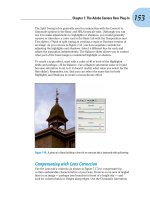Mineral nutrition (chapter 4)
Bạn đang xem bản rút gọn của tài liệu. Xem và tải ngay bản đầy đủ của tài liệu tại đây (2.32 MB, 21 trang )
Mineral Nutrition (chapter 4)
Mineral Nutrition
How plants acquire and use mineral nutrients
1. Why is mineral nutrition important?
2. What are the essential mineral nutrients?
• classification systems
3. Mineral nutrients in the soil
• nutrient availability
• adsorption to soil particles
• effects of pH
4. Roots and mineral nutrient acquisition
• root structure
• depletion zones
4. Mycorrhizae
5. Nitrogen - the most limiting soil nutrient
Why is mineral nutrition important?
1. Fertilization increases crop production
Crop
Yield,
tons/hectare
Fertilizer used, kg/hectare
Add more fertilizer nitrogen, get more crop production.
Crop
Yield,
tons/hectare
Nitrogen added, kg/hectare
Trends in
global use of
fertilizer N,
P, & K
Why is mineral nutrition important?
2. In most natural soils, the availability of mineral nutrients limits
plant growth and primary productivity.
Nutrient limitation is an important selective pressure and plants
exhibit many special traits related to the need to acquire and use
mineral nutrients efficiently.
2. What are the essential mineral nutrients?
Macronutrients - present in relatively high
concentrations in plant tissues.
N, K, P, Ca, Mg,S, Si
Nitrogen is most commonly limiting to productivity of natural and
managed soils. Phosphorus is next most limiting, and is most
limiting in some tropical soils.
Micronutrients - present in very low concentrations in
plant tissues.
All mineral nutrients together make up less than 4% of plant mass,
yet plant growth is very sensitive to nutrient deficiency.
Not considered mineral nutrients
Micronutrients are present in very low concentrations
ppm
Very low concentrations, but still essential
because of specialized roles in metabolism
How to classify all of these macro and
micro nutrients?
By biochemical function
3. Mineral nutrients in the soil
Larson
Soils particles are generally negatively charged and so bind
positively charged nutrient ions (cations).
Cation Exchange Capacity refers to a soil’s ability to bind cations.
NH4+, NO3-, Cl-, PO4-2, SO4-2
Soil pH influences availability of soil nutrients.
4. Roots and mineral nutrient acquisition
Fine roots and root hairs
“mine” the soil for
nutrients.
Mycorrhizal hyphae do
this even better.
Fig. 5.7
Fig. 5.8
More on Nitrogen
•Why is N so important for plant growth?
•What percentage of the mass of plant tissues is N?
•What kinds of compounds is N found in?
•Why is there a strong relationship between the N
concentration of leaves and photosynthesis?









